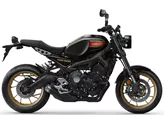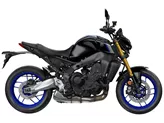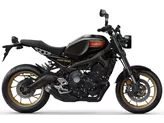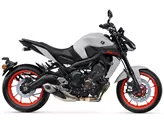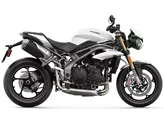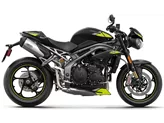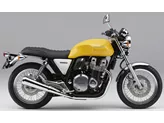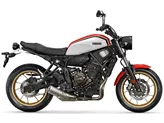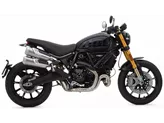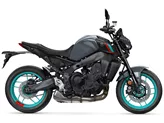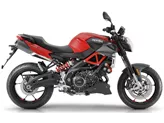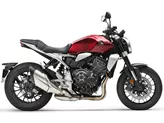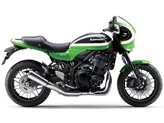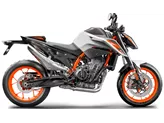Yamaha XSR900 2016 vs. Triumph Speed Triple S 2016

Yamaha XSR900 2016

Triumph Speed Triple S 2016
Overview - Yamaha XSR900 2016 vs Triumph Speed Triple S 2016
The Yamaha XSR900 2016 and the Triumph Speed Triple S 2016 are both naked bikes with similar engine types, in line three-cylinder engines. However, there are several differences between the two models.
In terms of engine power, the Triumph Speed Triple S 2016 has a clear advantage with 140 HP compared to the Yamaha XSR900 2016's 115 HP. The Triumph also has a higher torque of 112 Nm compared to the Yamaha's 87.5 Nm. This means that the Triumph will likely offer more acceleration and power on the road.
Both bikes have liquid cooling systems and three cylinders, which provide smooth and efficient performance. They also have similar suspension setups, with upside-down telescopic forks at the front and monoshock absorbers at the rear. The chassis on both bikes is made of aluminum and has a twin tube design, providing strength and stability.

Yamaha XSR900 2016
In terms of braking, the Triumph Speed Triple S 2016 has larger front discs with a diameter of 320 mm compared to the Yamaha XSR900 2016's 298 mm discs. This may result in better braking performance and shorter stopping distances for the Triumph.
In terms of dimensions and weights, the two bikes are quite similar. The Yamaha has a slightly longer wheelbase of 1440 mm compared to the Triumph's 1435 mm. The seat height on the Yamaha is also slightly lower at 815 mm compared to the Triumph's 825 mm. However, the Triumph is heavier, weighing 214 kg compared to the Yamaha's 188 kg. The Yamaha also has a slightly smaller fuel tank capacity of 14 liters compared to the Triumph's 15.5 liters.

Triumph Speed Triple S 2016
When it comes to strengths, the Yamaha XSR900 2016 has a greedy engine, well-tuned riding modes, and ABS and TC as standard features. It also has an authentic modern design and clean workmanship. On the other hand, the Triumph Speed Triple S 2016 has a distinctive three-cylinder engine with a unique sound, a distinctive look, good brakes, a sporty seating position, and a well-functioning electronics package.
In terms of weaknesses, the Yamaha XSR900 2016 has a hard chassis, and the seat could be more comfortable. Additionally, the speedblock design is already present on many other Yamaha models, which may make it less unique. The Triumph Speed Triple S 2016, on the other hand, could have a more responsive engine at the bottom end and may have somewhat sluggish handling.
Overall, the Triumph Speed Triple S 2016 offers more power and a slightly better braking system compared to the Yamaha XSR900 2016. However, the Yamaha has a lower weight and a slightly more comfortable seat. Both bikes have their own strengths and weaknesses, and the choice between them will depend on individual preferences and priorities.
Technical Specifications Yamaha XSR900 2016 compared to Triumph Speed Triple S 2016
Pros and Cons in comparison
Pros and Cons in comparison
Yamaha XSR900 2016

The XSR900 combines the performance of a sporty streetfighter with the look of a pleasing, cleanly finished retro naked bike. In doing so, the Japanese make use of their own history, which can be found bundled and without gaps in the archive of the design agency that has been working for Yamaha for 60 years. It adopts the virtues of the MT-09 and has mended some of its weaknesses. It rides more harmoniously, more controlled and, if desired, more relaxed. Only the comfort, and thus the rider, suffers from the tight chassis on bad roads. You have to be a little bit sensitive when it comes to a neo-classic.
Triumph Speed Triple S 2016

The Speed Triple remains true to its line in the latest generation - a wonderfully sharp naked bike that characterises the streetfighter style like hardly any other model. It only makes limited sense for the racetrack - of course, the roaring three-cylinder engine with 140 hp is enormous fun and the Fafhrwerk shows no gross weaknesses, but there is a Speed Triple R with Öhlins suspension elements that naturally feels more at home on the racetrack. All in all, the Speed Triple S is an excellent country road fighter that also has a lot to offer in terms of looks.
Price Comparison Avarage Market Price Yamaha XSR900 vs Triumph Speed Triple S
There are a few key differences between a Yamaha XSR900 2016 and a Triumph Speed Triple S 2016. There are the same number of bikes of both models available on the 1000PS.de marketplace, specifically 5. It takes less time to sell a Yamaha XSR900 with 77 days compared to 93 days for a Triumph Speed Triple S. Since model year 2016 1000PS.de editors have written 30 reviews for the Yamaha XSR900 and 6 reviews for the Triumph Speed Triple S since model year 2016. The first review for the Yamaha XSR900 was published on 11/25/2015 and now has more than 17,600 views. This compares to more than 10,300 views for the first review on Triumph Speed Triple S published on 10/23/2011.


